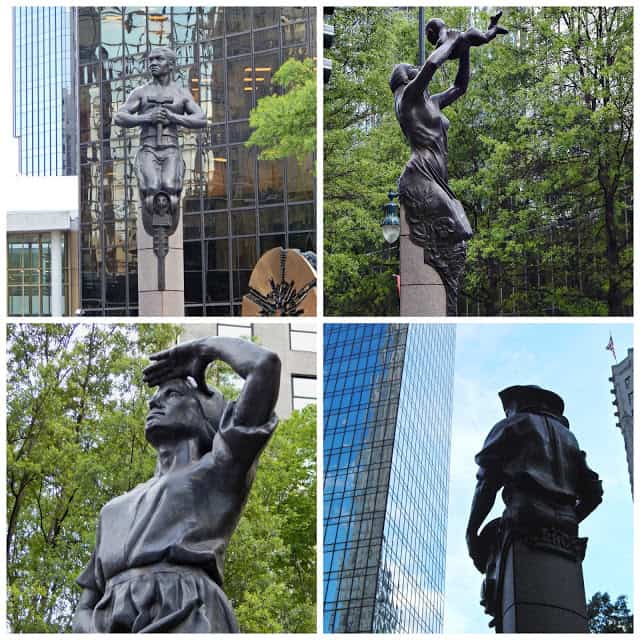Taking a walking tour of Uptown Charlotte, North Carolina was beautiful. On our walk, we ended up at the intersection of Trade and Tryon Streets and checked out the Four Corners Statues. This particular four corners, named Independence Square, is the heart of Uptown and it felt as though the entire city met and moved on from these two streets.

While waiting for the crossing signal, The Kid and I couldn’t help but notice the bronze statues at each of the corners. Weighing in at 5,000 pounds each and sitting on a slender granite base, The four statues face inwards and represent the city of Charlotte‘s past and future, each telling a story since they were placed in 1995 by creator Raymond Kaskey. From the top left and working clockwise, here’s the scoop:
What do the Four Corners Statues Stand for?
Transportation: Highlighting the African American prominence in building the railroad that runs through Charlotte, the creation of the railroad turned Charlotte into quite the transportation hub in the 1800’s. Look closely enough and you’ll notice the number 1401 which signifies “Charlotte”- a steam locomotive that used to pull the trains through the city.
The Future: Highlighting all of the potential that the city has for its future, a mother and her child are depicted in this statue. See the flowers and branches around the mother’s legs? Those are dogwood- the state flower of North Carolina. Take a closer look and you’ll catch the hornet’s nest signifying the nickname Charlotte was given early on.
Commerce: There’s a pan in this man’s hands- a gold pan! Depicting a 19th Century gold prospector, this statue was in honor of America’s very first gold rush occurring in Charlotte. If the name Alan Greenspan rings a bell then its face should, too. The former Federal Reserve Chairman’s face was the template for the statue.
Industry: This gorgeous statue represents a common scene in Charlotte during its early days- women mill workers. Highlighting the female textile working force, this lady has a child at the hem of skirt depicting the common practice of children working in the mills right along with their parents.
